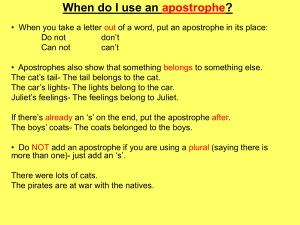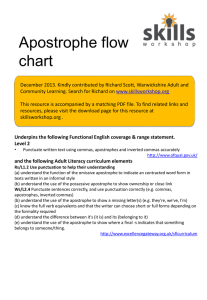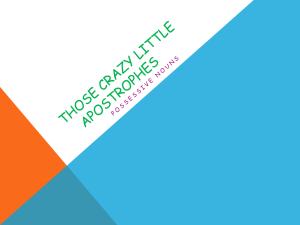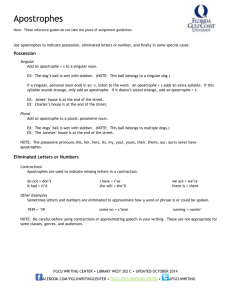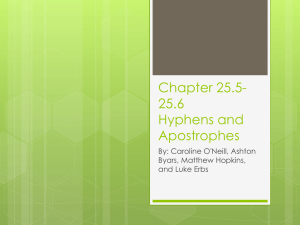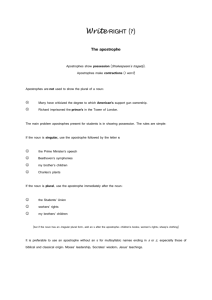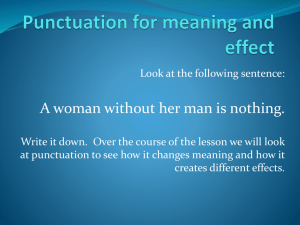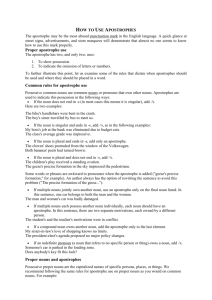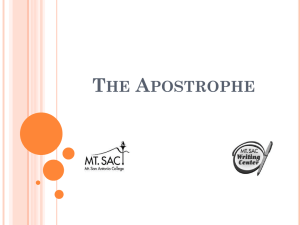Apostrophes_consultant copy
advertisement
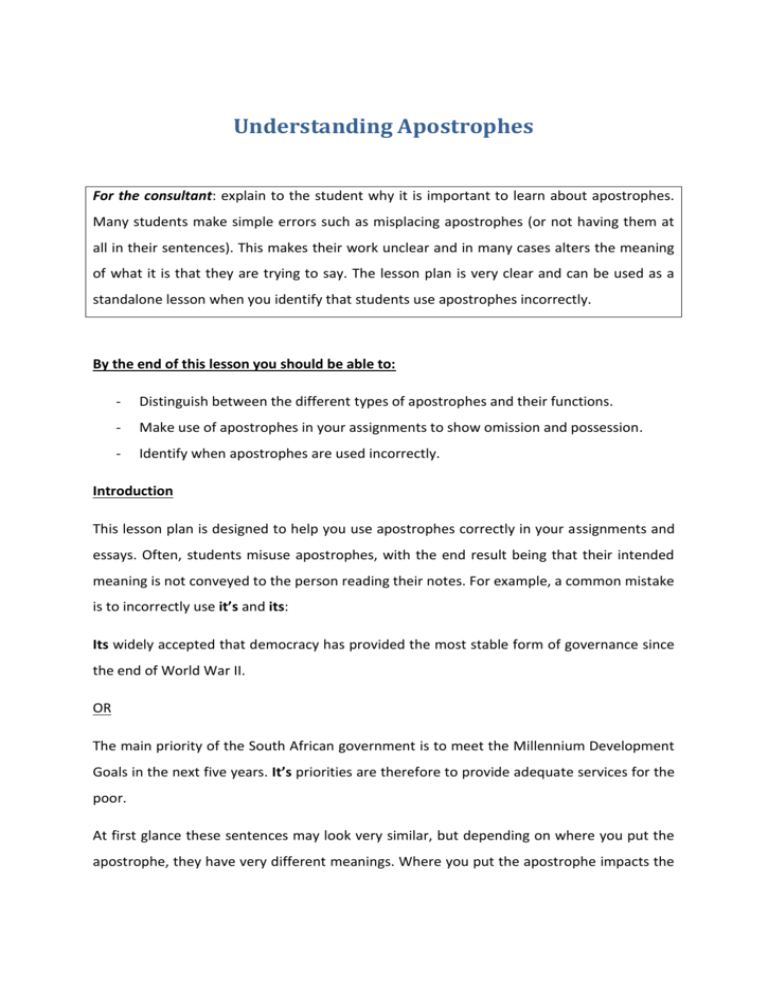
Understanding Apostrophes For the consultant: explain to the student why it is important to learn about apostrophes. Many students make simple errors such as misplacing apostrophes (or not having them at all in their sentences). This makes their work unclear and in many cases alters the meaning of what it is that they are trying to say. The lesson plan is very clear and can be used as a standalone lesson when you identify that students use apostrophes incorrectly. By the end of this lesson you should be able to: - Distinguish between the different types of apostrophes and their functions. - Make use of apostrophes in your assignments to show omission and possession. - Identify when apostrophes are used incorrectly. Introduction This lesson plan is designed to help you use apostrophes correctly in your assignments and essays. Often, students misuse apostrophes, with the end result being that their intended meaning is not conveyed to the person reading their notes. For example, a common mistake is to incorrectly use it’s and its: Its widely accepted that democracy has provided the most stable form of governance since the end of World War II. OR The main priority of the South African government is to meet the Millennium Development Goals in the next five years. It’s priorities are therefore to provide adequate services for the poor. At first glance these sentences may look very similar, but depending on where you put the apostrophe, they have very different meanings. Where you put the apostrophe impacts the meaning of the word(s) you are using. By the end of this lesson, you should be able to identify why the two examples above are incorrect. Lastly, this lesson plan is useful for you to improve the quality and clarity of your writing. It helps the person reading your work to understand what you mean by words such as you’re, its or won’t. LESSON PLAN Apostrophes have 2 functions: 1. They show omission This means that the apostrophe takes the place of a letter that is left out of the word. The apostrophe shortens the word to make reading easier and less confusing. To shorten a word is also called to contract the word. Apostrophes are therefore used in contractions. For example: It is It’s She is She’s Had not Hadn’t Do not Don’t Should not Shouldn’t NB: it’s differs from its While it’s shows the omission of ‘i’ (from it is), its shows something possesses something else. Example: The army rallied its troops. In this case the troops are part of/belong to the army. In order to avoid the repetition of the noun, ‘its’ replaces the noun. Otherwise your sentence would read as follows: The army rallied the army’s troops. In academic writing it is preferable that students write out the word in full rather than use contractions. Although in some cases (such as in the army example above) it is better to use contractions. Consult with your tutor when you are in doubt. 2. Apostrophes show possession This means that apostrophes show when a noun owns an object. For example: If the suitcase belongs to Michael, An apostrophe would show that he owns the suitcase as follows: It is Michael’s suitcase. Using an apostrophe here makes the sentence shorter and easier to read. Below are some rules on how to use an apostrophe for possession: Place an apostrophe and ‘s’ after a singular noun Example: The students discussed Locke’s views. In the above example, Locke is a singular proper noun. His views come from him; therefore, they belong to him. Hence, an apostrophe and‘s’ is placed directly after his name. The apostrophe and ‘s’ follow a singular noun that ends in an ‘s’ too Example: The students also discussed Hobbes’s views. The apostrophe and ‘s’ follow a plural noun Example: The government bettered women’s rights. Place only an apostrophe after a plural noun that ends in ‘s’ Example: Contemporary realists challenged structural realists’ claims. In the case of joint possession (where two people possess the same thing) addan apostrophe and ‘s’ to the last noun only Example: Thandi and Jess’s politics lecture started at three o’clock. In the above example, Thandi and Jess share the same politics lecture; therefore, an apostrophe and ‘s’ only follows Jess’s name. NB: When two do not possess the same thing, you need to place an apostrophe after each noun. Example 1:The girl held her mom’s and dad’s hand. In the above example, because the mom and dad do not possess the same hand, the apostrophe goes after “mom’ and ‘dad’. Example 2: They included Locke’s and Hobbes’s views in the syllabus. In the above example, Locke holds different views to Hobbes; they do not possess the same views. Therefore, an apostrophe and ‘s’ goes after each political thinker. NB: Never use an apostrophe with possessive pronouns: his, hers, its, theirs, ours, yours, whose. They already show possession, so they do not need an apostrophe.1 For example don’t make the following mistakes: Incorrect: Who’s cell phone is ringing? Correct: Whose cell phone is ringing? Incorrect: This book is her’s. Correct: This book is hers. Incorrect: Your’s sincerely Correct: Yours sincerely 1 [This information was sourced from Apostrophes. http://www.grammarbook.com/punctuation/apostro.asp (online: 22/08/2012)] Possessive nouns do not require an apostrophe. EXERCISES Activity 1 Write sentences beginning with each of the following terms – but shorten them with apostrophes 1) (We will) We’ll definitely attend all of our lectures this week. 2) (I cannot) I can’t make it to school on Friday because I feel a bit sick. 3) (They are) They’re off to the library to do some studying for tomorrow’s test. Activity 2 Place the apostrophe in the correct place to show possession. 1) One of the UN’s aims is to encourage cooperation amongst nations.2 2) The world challenged Germany’s ideologies. 3) Michel’s law applied even to socialist parties.3 4) The president acted against the people’s wishes. 5) The United States’ sanctions put pressure on the apartheid regime. 2 [This sentence is taken from: The United Nations, http://www.un.org/en/aboutun/index.shtml (online: 22/08/2012)] 3 [This sentence is taken from: Hague, Harrop and Breslin. 1992. Comparative Government and Politics: An Introduction. (Hampshire: Macmillan), pp.13] Activity 3 Using the noun in the brackets (which does the possessing); write your own sentences containing apostrophes that show possession. Example 1: Question: (President)…….. Answer: The people assembled to listen to the president’s speech. 1) (Machiavelli) …………………………………………………………………........ 2) (Smuts)……………………………………………………………………………... 3) (Majoritarian electoral system) ……………………………………………………..

